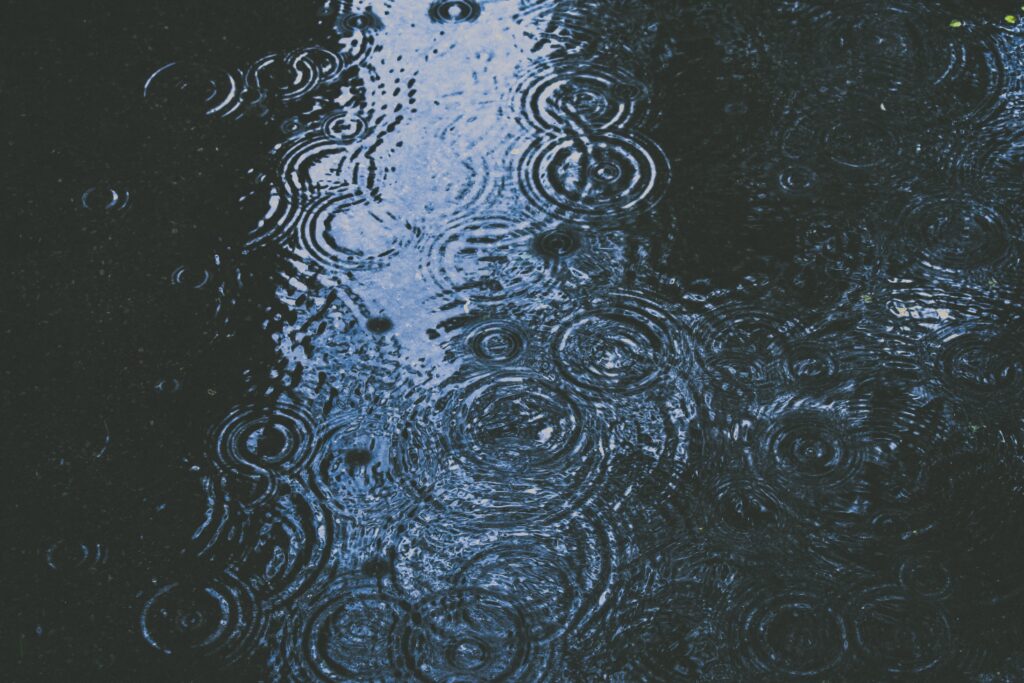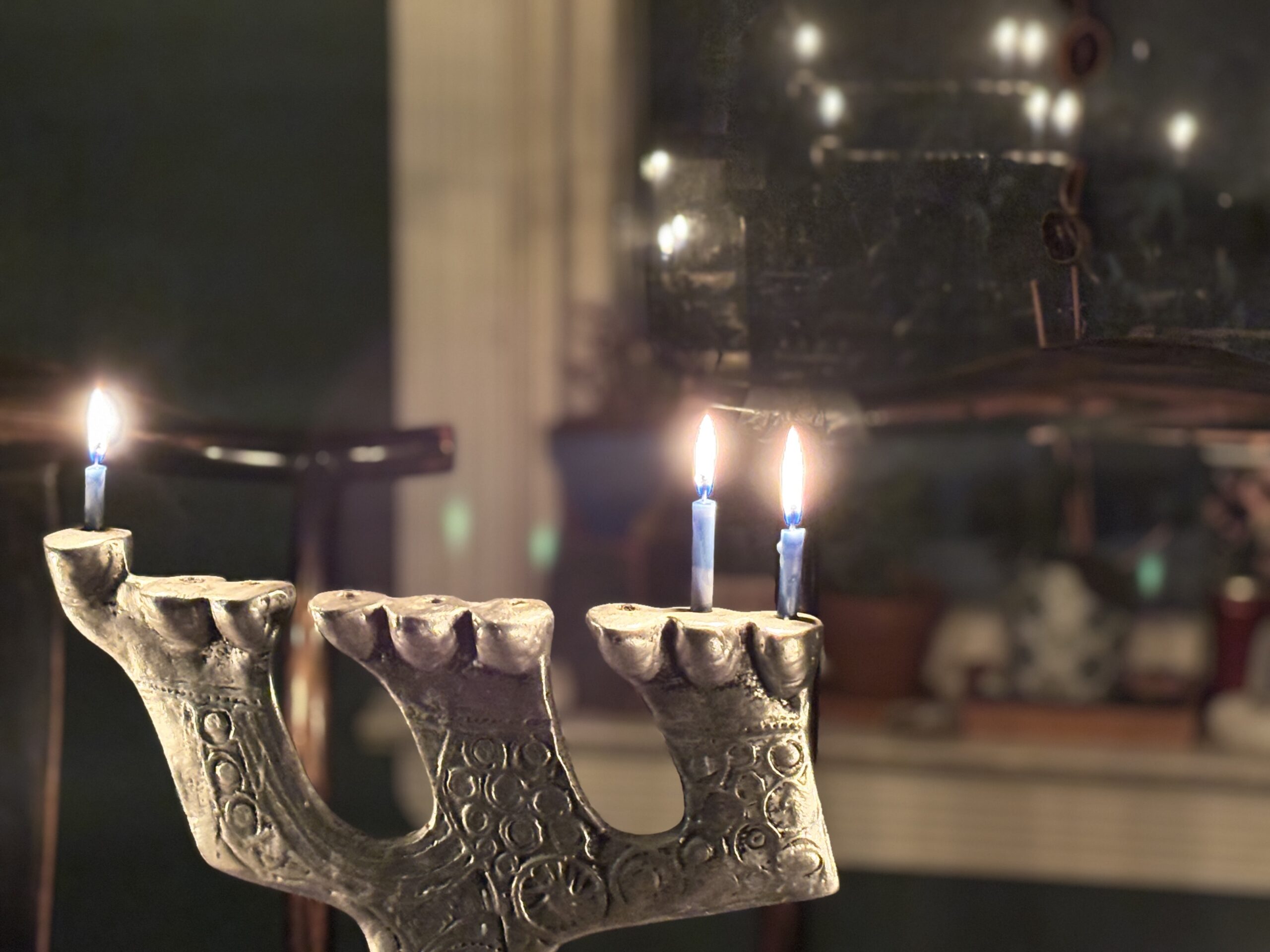Referencing the story of Ḥoni HaM’ageil (in Mishnah Ta’anit 3:8 and Ta’anit 23a)
Purpose: To bring Jews together to celebrate Shemini Atzeret, which is (according to Tractate Sukkah, 48a) “a holiday in its own right” (regel bifnei atzmo/ רגל בפני עצמו) typically lost between the hustle of Sukkot and Simchat Torah. This ritual will introduce the concept of praying for rain in a more concrete manner than the Tefilat HaGeshem piyyut (a liturgical poem about the beginning of rain season) found in traditional siddurim (prayer books). It will also address the overlap between Shemini Atzeret and Sukkot, by including a meal in the sukkah without a bracha (blessing) for the sukkah or the rituals of the lulav and etrog. Lastly, this ritual reflects a theology wherein people help to carry out the work of God.
Location: a large backyard with a sukkah
Materials needed:
1. A long rope (to make a visible circle on the ground)
2. Water pitchers filled with water
3. A chair or table to hold the water pitchers
4. Boxes in which to pack donated goods
5. Nonperishable foods to donate
6. Photocopies of this ritual.
7. A sukkah
8. Tables and chairs inside the sukkah
9. Food and other supplies for a feast (such as plates, serving containers, silverware, etc.)
Preparation:
Step 1: Prepare backyard for Sukkot as usual (with a sukkah, table, chairs, etc.)
Step 2: Invite guests to attend your Rain Feast. Instruct them to bring at least one nonperishable food to donate.
Step 3: Print out copies of the ritual below, so guests can participate in it fully.
Step 4: Position the rope on the ground so as to make a circle large enough to enclose all guests.
Step 5: Fill water pitchers and have them sitting on a table or chair near the circle.
Step 6: Place boxes near the sukkah, ensuring that they are far enough away from the circle that they will not get wet during the ritual.
Ritual
Welcome guests and invite them into the backyard. Have everyone stand outside of the rope circle to begin.
Now the leader will tell the story of Ḥoni Ha-M’ageil:
Long ago, in the Land of Israel, there was a terrible drought. Usually the rain fell in abundance between Shemini Atzeret and Passover, but this year there hadn’t been a drop, and Passover was only a couple of weeks away! The people were almost ready to give up hope. Without rain, there would be no crops and no way to survive. In desperation, they turned to a man named Ḥoni Ha-M’ageil, Ḥoni the Circle Drawer, and asked him to pray for rain. Ḥoni had an especially close relationship with God and a strong desire to help others. He instructed the people to bring their ovens, which they kept outside in those days, into their homes, so that the ovens would not be destroyed by rain. And then he prayed for rain. The people were hopeful. But no rain fell.
Some people would have given up then, after praying to no avail, but not Ḥoni. He was a persistent man. Ḥoni then drew a circle in the sand and stood right in the middle of it and said, “Ribbono shel Olam! Master of the Universe, Your children have turned to me, because I am almost like a member of Your family. I swear by Your Great Name—I will not move from this circle until You take pity on Your children!”
Suddenly it began to drizzle. Some people would have stopped then, with their promise to bring rain fulfilled, but not Ḥoni. Ḥoni could hear his disciples saying, “We look to you to save us from death. This drizzle will not be enough.”
So Ḥoni said to God, “This is not what I wanted. I wanted enough rain to fill up every cistern, ditch, and cavern.”
Then it began to rain violently. Some say that each individual raindrop was the size of a softball, if not larger. Most people would have stopped then, and gone inside to seek shelter from the storm, but not Ḥoni. Ḥoni could hear his disciples saying, “We look to you to save us from death. This storm is powerful enough to destroy the whole world!”
So Ḥoni said to God, “This is not what I meant either. I am asking You for the rain of blessing and graciousness.”
Now it rained the right way, but there was still so much water that the Israelites had to head for high ground. They all gathered at the Temple Mount, the highest point then in Jerusalem.
Then Ḥoni’s disciples came up to him and said, “Just as you prayed for it to rain, now pray for it to go away!”
Ḥoni prayed once again, “Ribbono shel Olam! Master of the Universe, Your children are a delicate people. They cannot endure too much or too little of anything. May it be Your will that the rain cease and there be relief for the world.”
The wind began to blow, the clouds dispersed, and the sun shone bright once again. The people went out into the fields and were able to gather fresh mushrooms and vegetation for a great and wonderful feast.
After telling the story, the leader will explain the holiday of Shemini Atzeret and its connection to rain:
Shemini Atzeret follows the holiday of Sukkot and marks the day that we traditionally begin to pray for rain, since it is at approximately this time of year that the rainy season begins in Eretz Yisrael (the Land of Israel). Today we will be praying for rain in a new way.
Then the leader invites all of the guests into the circle and hands them a copy of the liturgy. After everyone has entered the circle, recite the following together:
In the absence of Ḥoni Ha-M’ageil,
We come with a plan that cannot fail.
We ask that You bless the earth with rain,
But realize that action works as a chain,
So we will pour the first few drops,
And pray ‘til Pesach it never stops.
Pass pitchers of water around for participants to pour (very lightly) in all directions outside of the circle. (Note: Do not pour too much, or participants may have to walk through mud in order to exit the circle.) Once everyone has poured water, recite together:
So too, may Adonai shower us all with blessing
And provide for the needs which are most pressing.
We pray for all to enjoy a harvest of bounty,
Here in ______ and in every county.
May no one go hungry even once this year,
Whether friend or stranger, far or near.
Let our deeds reinforce our heartfelt prayers.
Let us take action before taking our chairs.
Participants exit the circle and retrieve the food they brought to donate. Then participants pack the food into boxes, which will be taken to a local food pantry.
When all of the donations have been packed, recite together:
בָּרוּךְ אַתָּה יְיָ הַמֵּכִין מָזוֹן לְכָל בְּרִיּוֹתָיו.
Ba-ruch a-tah A-do-nai, ha-mei-chin ma-zon l’-chol b’-ri-yo-tav.
Blessed are You, Adonai, who provides enough food for all of Your creations.
After this part of the ritual, everyone can enjoy a festive meal in the sukkah without saying the blessing for dwelling in the sukkah or using the lulav and the etrog, because Shemini Atzeret is no longer Sukkot (even though some have the custom to eat a meal in the sukkah on Shemini Atzeret). While you eat, you may wish to discuss how it felt to participate in this new ritual.
You could also organize a text study to take place after the meal that explores the differences between the two Ḥoni Ha-M’ageil stories in Mishnah Ta’anit 3:8 and Ta’anit 23a (as well as the version told in the ritual above). The texts from the Mishnah and Talmud are presented below: What was added or omitted in each version? How different are these stories?
Mishnah Ta’anit 3:8 (as translated by Jacob Neusner)
They said to Ḥoni, the circle drawer, “Pray for rain.” He said to them, “Go and take in the clay ovens used for Passover, so that they not soften in the rain which is coming.” He prayed, but it did not rain. What did he do? He drew a circle and stood in the middle of it and said before Him, “Lord of the world! Your children have turned to me, for before You I am like a member of the family. I swear by your great name—I’m simply not moving from here until you take pity on your children!”
It began to rain drop by drop. He said, “This is not what I wanted, but rain for filling up cisterns, pits, and caverns.” It began to rain violently. He said, “This is not what I wanted, but rain of good will, blessing, and graciousness.” Now it rained the right way, until Israelites had to flee from Jerusalem up to the Temple Mount because of the rain. Now they came and said to him, “Just as you prayed for it to rain, now pray for it to go away.” He said to them, “God, see whether the stone of the strayers is disappeared.”
Simeon b. Shetah said to him, “If you were not Ḥoni, I should decree a ban of excommunication against you. But what I am I going to do to you? For you importune before the Omnipresent, so he does what you want, like a son who importunes his father, so he does what he wants.
Babylonian Talmud Ta’anit 23a (Soncino translation)
IT HAPPENED THAT THE PEOPLE SAID TO ḤONI, THE CIRCLE DRAWER etc. Once it happened that the greater part of the month of Adar had gone and yet no rain had fallen. The people sent a message to Ḥoni the Circle Drawer, Pray that rain may fall. He prayed and no rain fell. He thereupon drew a circle and stood within it in the same way as the prophet Habakuk had done, as it is said, I will stand upon my watch, and set me upon the tower etc. (Habakuk 2:1) He exclaimed [before God], Master of the Universe, Your children have turned to me because [they believe] me to be a member of Your house. I swear by Your great name that I will not move from here until You hast mercy Upon Your children!
Rain began to drip and his disciples said to him, We look to you to save us from death (Rashi: for confession of sins.]) We believe that this rain came down merely to release you from your oath. Thereupon he exclaimed: It is not for this that I have prayed, but for rain [to fill] cisterns, ditches and caves. The rain then began to come down with great force, every drop being as big as the opening of a barrel and the Sages estimated that no one drop was less than a log. His disciples then said to him: Master, we look to you to save us from death; we believe that the rain came down to destroy the world
Thereupon he exclaimed before [God], It is not for this that l have prayed, but for rain of benevolence, blessing and bounty. Then rain fell normally until the Israelites [in Jerusalem] were compelled to go up [for shelter] to the Temple Mount because of the rain. [His disciples] then said to him, Master, in the same way as you have prayed for the rain to fall pray for the rain to cease. He replied: I have it as a tradition that we may not pray on account of an excess of good. Despite this bring unto me a bullock for a thanks-giving-offering.] They brought unto him a bullock for a thanks-giving-offering and he laid his two hands upon it and said, Master of the Universe, Your people Israel whom You hast brought out from Egypt cannot endure/survive an excess of good nor an excess of punishment; when You were angry with them, they could not endure it; when You did shower upon them an excess of good they could not endure it; may it be Your will that the rain may cease and that there be relief for the world. Immediately the wind began to blow and the clouds were dispersed and the sun shone and the people went out into the fields and gathered for themselves mushrooms and truffles. Thereupon Simeon b. Shetah sent this message to him, Were it not that you are Ḥoni I would have placed you under the ban; for were the years like the years [of famine in the time] of Elijah (in whose hands were the keys of Rain, I Kings 17:1)) would not the name of Heaven be profaned through you? ) [i.e. Ḥoni would not have hesitated to force, so to speak, the hand of Heaven even in the face of an oath such as Elijah had made in the name of God that there would be no rain for years (1 Kings XVII, 1ff).] But what shall I do unto you who acts petulantly before the Omnipresent and He grants your desire, as a son who acts petulantly before his father and he grants his desires.













